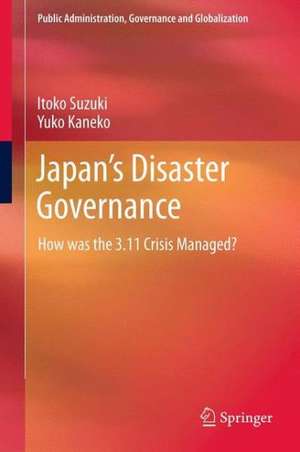Japan’s Disaster Governance: How was the 3.11 Crisis Managed?: Public Administration, Governance and Globalization, cartea 4
Autor Itoko Suzuki, Yuko Kanekoen Limba Engleză Hardback – 8 ian 2013
This book provides a case of the disaster governance of Japan, by presenting information and analyses on what happened in the Magnitude 9 Great East Japan Earthquake that caused the huge tsunami and the INES Level 7 Fukushima nuclear power plants accidents on March 11, 2011. In examining this Japanese case study, this book illustrates the socio-economic damage of the stricken areas together with the overall picture of the disasters. It examines Japan’s capacity for disaster governance and it’s crisis management system in response to the most devastating disaster that the country has ever encountered since the end of WWII. It also offers preliminary findings learned from this experience in the Japan’s public administration and governance systems, challenged to be more accountable and transparent during the recovery and reconstruction efforts now in progress.
Toate formatele și edițiile
| Toate formatele și edițiile | Preț | Express |
|---|---|---|
| Paperback (1) | 632.05 lei 6-8 săpt. | |
| Springer – 8 feb 2015 | 632.05 lei 6-8 săpt. | |
| Hardback (1) | 636.80 lei 6-8 săpt. | |
| Springer – 8 ian 2013 | 636.80 lei 6-8 săpt. |
Din seria Public Administration, Governance and Globalization
- 15%
 Preț: 638.11 lei
Preț: 638.11 lei - 15%
 Preț: 646.75 lei
Preț: 646.75 lei - 15%
 Preț: 653.00 lei
Preț: 653.00 lei - 18%
 Preț: 898.26 lei
Preț: 898.26 lei - 15%
 Preț: 639.69 lei
Preț: 639.69 lei - 15%
 Preț: 643.34 lei
Preț: 643.34 lei - 15%
 Preț: 652.49 lei
Preț: 652.49 lei - 18%
 Preț: 1116.71 lei
Preț: 1116.71 lei - 18%
 Preț: 941.05 lei
Preț: 941.05 lei - 15%
 Preț: 635.80 lei
Preț: 635.80 lei -
 Preț: 389.70 lei
Preț: 389.70 lei - 15%
 Preț: 646.11 lei
Preț: 646.11 lei - 18%
 Preț: 893.40 lei
Preț: 893.40 lei - 15%
 Preț: 644.18 lei
Preț: 644.18 lei - 18%
 Preț: 726.23 lei
Preț: 726.23 lei - 15%
 Preț: 639.08 lei
Preț: 639.08 lei - 15%
 Preț: 643.48 lei
Preț: 643.48 lei - 15%
 Preț: 650.37 lei
Preț: 650.37 lei
Preț: 636.80 lei
Preț vechi: 749.19 lei
-15% Nou
Puncte Express: 955
Preț estimativ în valută:
121.85€ • 127.56$ • 100.82£
121.85€ • 127.56$ • 100.82£
Carte tipărită la comandă
Livrare economică 05-19 aprilie
Preluare comenzi: 021 569.72.76
Specificații
ISBN-13: 9781461461500
ISBN-10: 1461461502
Pagini: 124
Ilustrații: VIII, 116 p.
Dimensiuni: 155 x 235 x 13 mm
Greutate: 0.32 kg
Ediția:2013
Editura: Springer
Colecția Springer
Seria Public Administration, Governance and Globalization
Locul publicării:New York, NY, United States
ISBN-10: 1461461502
Pagini: 124
Ilustrații: VIII, 116 p.
Dimensiuni: 155 x 235 x 13 mm
Greutate: 0.32 kg
Ediția:2013
Editura: Springer
Colecția Springer
Seria Public Administration, Governance and Globalization
Locul publicării:New York, NY, United States
Public țintă
ResearchCuprins
Contents.- Introduction.- Brief overview of the Tohoku 3.11 Mega Earthquake, Tsunami and Fukushima NPS Disasters.- Government institutions available at time of the 3.11disaster for the emergency management.- How the 3.11 emergency responses for the gigantic natural disasters were actually organized?.- Managing Fukushima NPS accidents: in particular focus on government crisis communication.- Road to Recovery and Reconstruction after the Great East Japan Earthquake.- Conclusion.
Notă biografică
Yuko Kaneko is a Professor of Public Administration at the University of Yamagata. She received an LLB from the University of Tokyo; previously Professor of the Local Autonomy College of Ministry of Internal Affairs and Communications (2004-2005); worked over 25 years for the Government of Japan in Ministry of Internal Affairs and Communications; published books and articles on administrative reform, environmental management, local governance, policy development, statistical analysis of household income and expenditure, etc. Itoko Suzuki, currently a member or on the editorial committee of a few public administration and management societies in Japan; previously Professor of International Administration at Ritsumeikan Asia Pacific University (2000- 2006); Kobe Women’s University (2006-2009), Shizuoka University of Arts and Culture (2000-2011); PhD in Public Administration from New York University (1980). Dr. Suzuki worked for 30 years at the United Nations Headquarters in New York on the United Nations Public Administration Programme of DESA (1969-2000); contributed several articles on administrative reforms, management development, and local environmental governance.
Textul de pe ultima copertă
Natural disasters are often multifaceted and cause severe damage. Disasters initiated locally can become national and even global crises. Today’s world urgently needs a new body of knowledge and techniques for the mitigation of and response to disaster. Central to such a body of knowledge are disaster preparedness, emergency and crisis management systems of government, of which capacity building is becoming an increasingly important element in public administration, management and governance. Today, disasters are to be managed by sound local, national, and global governance, through all the phases of preparedness, prevention, mitigation and then to relief, recovery and re-construction. During all these phases, government plays the most important role.
This book provides a case of the disaster governance of Japan, by presenting information and analyses on what happened in the Magnitude 9 Great East Japan Earthquake that caused the huge tsunami and the INES Level 7 Fukushima nuclear power plants accidents on March 11, 2011. In examining this Japanese case study, this book illustrates the socio-economic damage of the stricken areas together with the overall picture of the disasters. It examines Japan’s capacity for disaster governance and it’s crisis management system in response to the most devastating disaster that the country has ever encountered since the end of WWII. It also offers preliminary findings learned from this experience in the Japan’s public administration and governance systems, challenged to be more accountable and transparent during the recovery and reconstruction efforts now in progress.
This book provides a case of the disaster governance of Japan, by presenting information and analyses on what happened in the Magnitude 9 Great East Japan Earthquake that caused the hugetsunami and the INES Level 7 Fukushima nuclear power plants accidents on March 11, 2011. In examining this Japanese case study, this book illustrates the socio-economic damage of the stricken areas together with the overall picture of the disasters. It examines Japan’s capacity for disaster governance and it’s crisis management system in response to the most devastating disaster that the country has ever encountered since the end of WWII. It also offers preliminary findings learned from this experience in the Japan’s public administration and governance systems, challenged to be more accountable and transparent during the recovery and reconstruction efforts now in progress.
This book provides a case of the disaster governance of Japan, by presenting information and analyses on what happened in the Magnitude 9 Great East Japan Earthquake that caused the huge tsunami and the INES Level 7 Fukushima nuclear power plants accidents on March 11, 2011. In examining this Japanese case study, this book illustrates the socio-economic damage of the stricken areas together with the overall picture of the disasters. It examines Japan’s capacity for disaster governance and it’s crisis management system in response to the most devastating disaster that the country has ever encountered since the end of WWII. It also offers preliminary findings learned from this experience in the Japan’s public administration and governance systems, challenged to be more accountable and transparent during the recovery and reconstruction efforts now in progress.
This book provides a case of the disaster governance of Japan, by presenting information and analyses on what happened in the Magnitude 9 Great East Japan Earthquake that caused the hugetsunami and the INES Level 7 Fukushima nuclear power plants accidents on March 11, 2011. In examining this Japanese case study, this book illustrates the socio-economic damage of the stricken areas together with the overall picture of the disasters. It examines Japan’s capacity for disaster governance and it’s crisis management system in response to the most devastating disaster that the country has ever encountered since the end of WWII. It also offers preliminary findings learned from this experience in the Japan’s public administration and governance systems, challenged to be more accountable and transparent during the recovery and reconstruction efforts now in progress.
Caracteristici
Presents information and analyses on the Magnitude 9 Great East Japan Earthquake and INES Level 7 Fukushima nuclear power plants accidents on March 11, 2011 Illustrates the socio-economic damage of the stricken areas together with the overall picture of the disasters in Japan Examines Japan’s capacity for disaster governance and crisis management system Offers the latest information on Japan’s administrative reforms now being explored for better disaster governance in Japan?? Includes supplementary material: sn.pub/extras

















